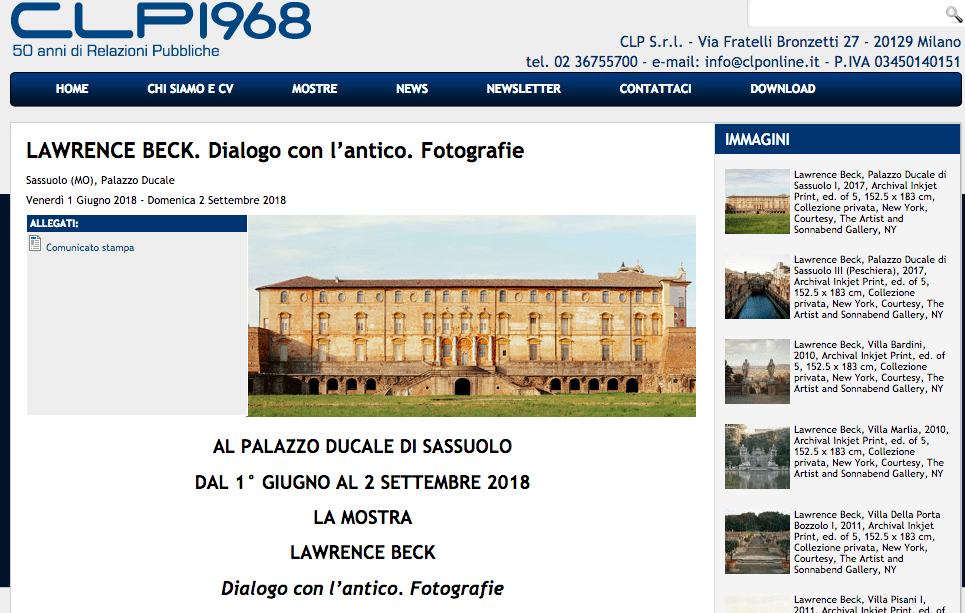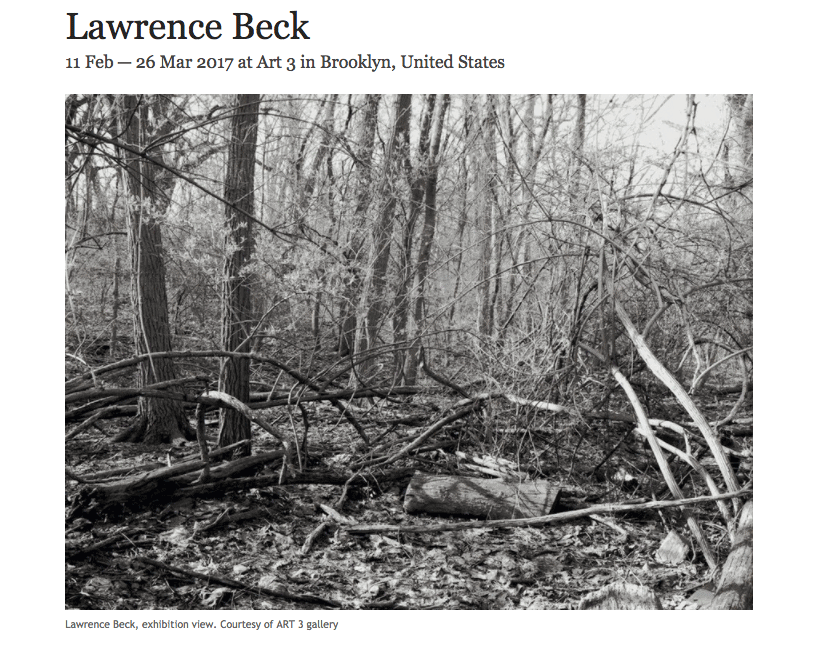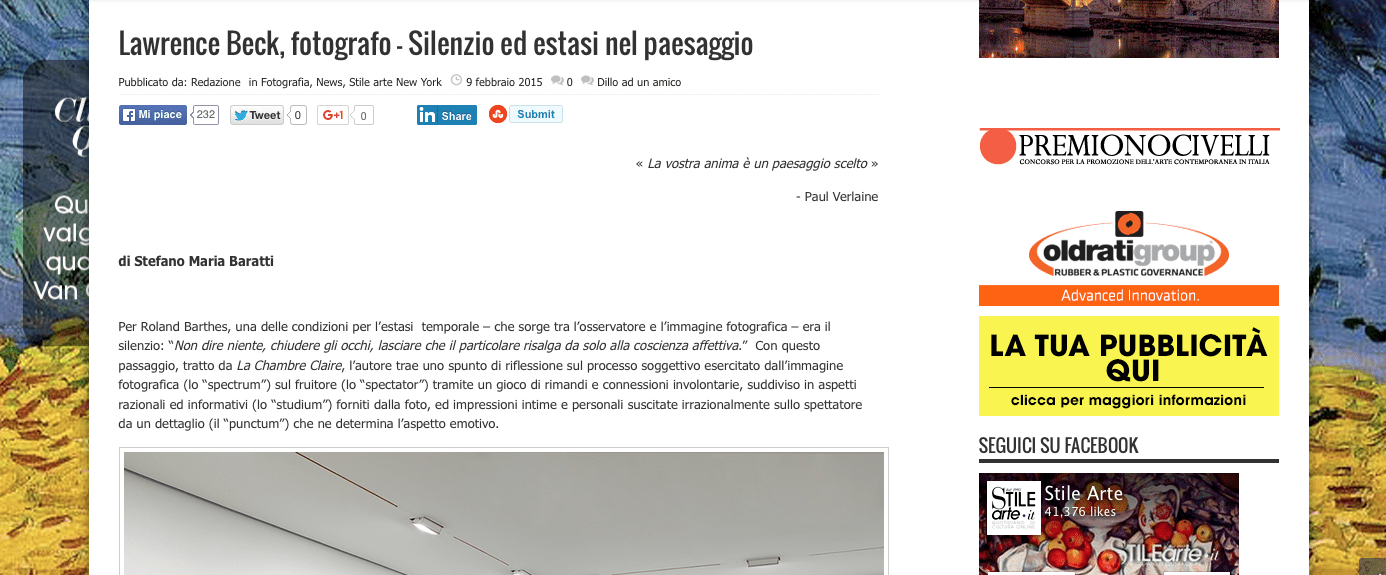http://www.clponline.it/mostre/lawrence-beck-dialogo-con-l’antico-fotografie
Press
New Projects
A wedding is a ceremony where two people or a couple are united in marriage. Wedding traditions and customs vary greatly between cultures, ethnic groups, religions, countries, and social classes. Most wedding ceremonies involve an exchange of marriage vows by the couple, presentation of a gift (offering, ring(s), symbolic item, flowers, money), and a public proclamation of marriage by an authority figure. Special wedding garments are often worn, and the ceremony is sometimes followed by a wedding reception. Music, poetry, prayers or readings from religious texts or literature are also commonly incorporated into the ceremony.
Common elements across cultures
Some cultures have adopted the traditional Western custom of the white wedding, in which a bride wears a white wedding dress and veil. This tradition was popularized through the marriage of Queen Victoria. Some say Victoria’s choice of a white gown may have simply been a sign of extravagance, but may have also been influenced by the values she held which emphasized sexual purity.Within the modern ‘white wedding’ tradition, a white dress and veil are unusual choices for a woman’s second or subsequent wedding.
The use of a wedding ring has long been part of religious weddings in Europe and America, but the origin of the tradition is unclear. One possibility is the Roman belief in the Vena amoris, which was believed to be a blood vessel that ran from the fourth finger (ring finger) directly to the heart. Thus, when a couple wore rings on this finger, their hearts were connected. Historian Vicki Howard points out that the belief in the “ancient” quality of the practice is most likely a modern invention. “Double ring” ceremonies are also a modern practice, a groom’s wedding band not appearing in the United States until the early 20th century.
Traditional wedding clothing attire
Hindu ceremonies are usually conducted totally or at least partially in Sanskrit, the language of the Hindu scriptures. The wedding celebrations may last for several days and they can be extremely diverse, depending upon the region, denomination and caste. Mehendi ceremony is a traditional ritual in Hindu weddings, where Henna application takes place on bride’s hands and legs, before the wedding.
Civil wedding
A civil wedding is a ceremony presided over by a local civil authority, such as an elected or appointed judge, Justice of the Peace or the mayor of a locality. Civil wedding ceremonies may use references to God or a deity (except in UK law where readings and music are also restricted) but generally no references to a particular religion or denomination. They can be either elaborate or simple. Many civil wedding ceremonies take place in local town or city halls or courthouses in judges’ chambers.
On Wedding Photography
A wedding is a ceremony where two people or a couple are united in marriage. Wedding traditions and customs vary greatly between cultures, ethnic groups, religions, countries, and social classes. Most wedding ceremonies involve an exchange of marriage vows by the couple, presentation of a gift (offering, ring(s), symbolic item, flowers, money), and a public proclamation of marriage by an authority figure. Special wedding garments are often worn, and the ceremony is sometimes followed by a wedding reception. Music, poetry, prayers or readings from religious texts or literature are also commonly incorporated into the ceremony.
Common elements across cultures
Some cultures have adopted the traditional Western custom of the white wedding, in which a bride wears a white wedding dress and veil. This tradition was popularized through the marriage of Queen Victoria. Some say Victoria’s choice of a white gown may have simply been a sign of extravagance, but may have also been influenced by the values she held which emphasized sexual purity.Within the modern ‘white wedding’ tradition, a white dress and veil are unusual choices for a woman’s second or subsequent wedding.
The use of a wedding ring has long been part of religious weddings in Europe and America, but the origin of the tradition is unclear. One possibility is the Roman belief in the Vena amoris, which was believed to be a blood vessel that ran from the fourth finger (ring finger) directly to the heart. Thus, when a couple wore rings on this finger, their hearts were connected. Historian Vicki Howard points out that the belief in the “ancient” quality of the practice is most likely a modern invention. “Double ring” ceremonies are also a modern practice, a groom’s wedding band not appearing in the United States until the early 20th century.
Traditional wedding clothing attire
Hindu ceremonies are usually conducted totally or at least partially in Sanskrit, the language of the Hindu scriptures. The wedding celebrations may last for several days and they can be extremely diverse, depending upon the region, denomination and caste. Mehendi ceremony is a traditional ritual in Hindu weddings, where Henna application takes place on bride’s hands and legs, before the wedding.
Civil wedding
A civil wedding is a ceremony presided over by a local civil authority, such as an elected or appointed judge, Justice of the Peace or the mayor of a locality. Civil wedding ceremonies may use references to God or a deity (except in UK law where readings and music are also restricted) but generally no references to a particular religion or denomination. They can be either elaborate or simple. Many civil wedding ceremonies take place in local town or city halls or courthouses in judges’ chambers.
Stile e Arte
to read the article in Italian on Stile e Arte click here
Here’s the translation:
According to Roland Barthes, silence is on of the conditions needed for temporary ecstasy – between the viewer and the image – : “Say nothing, to shut my eyes, let the detail emerge to emotional knowledge”. In this excerpt from Camera Lucida, Barthes reflects upon the subjective process that the photographic image – or spectrum – plays on the observer – the spectator. A game of cross references and unintentional links, divided into rational and informative features also called studium, provided by the photograph, as well as an emotional side which includes intimate and personal feelings, irrationally aroused by a detail, or punctum.
In Lawrence Beck’s large prints, the silence evoked by landscape plays a leading role. It is the theme of an accurate perspective, a spectrum that records reality’s vibes by using lights, shadows and framing. This silence excludes the human presence. Nonetheless, it reveals his existence in a duality that implies two ontological abstractions. On the one hand, we see a uniformity of monumental architecture (parks and gardens), a motionless space unity (the classical concept of order that explores rationalism and myth). On the other hand, we experience the spontaneity of sensations linked with the contemplation of the ever-changing Nature – woods, mountains, valleys (Panta rei, reality as an the eternal stream)
Beck’s black and white and color photos take advantage of his old-school equipment’s limits in a personal way – he uses a Toyo 810 view camera, usually employed in architectural photography for outdoor shots – to show the inner beauty of nature. He combines pictorialism (an aestethic style born in the second half of 20th century to match photography with painting) with landscape photography, a significant depth of field and very long exposure times. The spectator enjoys two diametrically opposite kinds of compositions. First, the static space of gardens (or the archeological relic), as a system of visual axes inspired by the Italian Renaissance’s conception of perspective, a system which also recalls André Le Nôtre’s planimetries. Secondly, the representation of wilderness as en plein air work, used by the school of Barbizon and impressionist artists, especially Monet – furthermore, Beck dedicates a series of photographs to the Water Lilies of Giverny.
Among the author’s favorite subjects – shown in many occasions at the Sonnabend Gallery on evocative large prints – there are reflections between human being and environment, the perceptive nature of photography and the interaction between human subjectivity (outfield) and the objective nature of space (anthropic, cultural and natural). The artist switches from architecture to landscape in open spaces such as italian parks and gardens (Boboli, Caserta, Marlia, Ninfa, Villa Bardini) to a long and fascinating syncretism between history and geographical background (Via Appia Antica, Villa Barbarigo Pizzoni Ardemani, Villa Pisani, Acquedotti Romani) acting as a cultural interpreter that focuses without altering the picture and establishes bonds between the flow of time and evidences of human history. In this situation, we clearly see landscape (the “studium”) as a heritage and self-representing cultural identity, as a result of collective perception, a mirror of the viewer’s (“spectator”) mood, the only one entitled to alter the psychological unconscious.
The Art Historian Giulio Carlo Argan used to define the garden as an ”affected arrangement, based on geometrical or imaginary forms, cultivated land, in order to achieve a merely aesthetic result”. Therefore, the aesthetic character of Beck’s parks and gardens are connected primarily to the osmosis of nature as planning and arranging of pre-formed cultivations on a mock-up, an artificial arrangement of spaces for decorative purposes, where geometry and architecture, in a mutual relationship, play a role of “figurability” always linked with human planning. So, framings set up order and balance in a system where art, history and architecture merge to devise entropy and chaos normally linked with wild nature.
The parks and gardens series – despite the framing seems to avoid any involuntary element – do not depict reality merely as a recorder, instead it is an accurate process of inspecting and composing in a personal subjective way, where the use of color underlines chromatic differences due to the weather, that show light not as a deciding factor but as a mirror that traps both the monumental stillness of memory and the endless flowing of nature.
In an aesthetic dimension soaked with romanticism and neoclassicism, Beck drifts apart from either documentary photography or reportage, opposing pictorialism and his trustworthy view camera’s, whose setup allows a combination of focal lengths and long exposures, with a change of perspectives. In the printing process, the artist digitally scans the negative to make a final large scale print (about 152 x 185 cm); on the one hand this size allows the depiction of the images and, on the other hand, promotes a “perceptive landscape” along the lines of Eugène Atget, where the objection and tangible outdoor connect with the hidden and variable inner one. Beck’s large prints, jointly with the focal plane’s precision and the depth of field, make the viewers identify, tout court, with the artist’s contemporary vision, its silence and poetics.
In the Eight and Nine hundred’s meaning, the concept of landscape photography was strictly linked to standards of beauty and quality. It was a narrow point of view, if you consider that Fox Talbot e David Octavius Hill, the inventors of calotype, were able to make pictures of rural and urban landscapes. Those years, when amateur photography was not common, postcards showed up in the market as souvenir pictures of places, subjective memories, pioneering the middle-class devices (such as the first Kodak film cameras) that would replace postcards and vulgarize photography, even more in the digital era. Over the years artistic photography became independent thanks to the definition of “perspective landscape”, a word recently codified as “postcard beauty” but restored to mean preservation of natural beauty, importance of specific territories and panoramas.
Beck’s photos display unaltered the early results of landscape photography, as an accurate selection where neoclassical geometry of parks and gardens back up with wide views of natural beauty, in particular those on the Alpes and the Monte Rosa – well-known mountain and appreciated for its glaciers – and its flora.
Beck spent years in the Aosta Valley and is a profound connoisseur of its beauty. He recreates his past by defining inner landscapes, pointing his lens to stony stretches of land, cliffs, streams, buttercups and other magnificent alpine flora species. It is a vision purely subjective, undoubtedly linked to life, memories, emotions connected with the landscape, where our past – not the fictitious monument or theatrical stage – emerges from experience and by a bond with the land, from deep personal feelings. From this point of view landscape is a social outcome, not a static affection but a dynamic one. Beck sticks to his old-school camera until the end, participating to an interaction between human subjectivity and the objective features of space, the “punctum” that defines its emotional state.
Ultimately, in Beck’s oeuvres, in this fascinating display between architecture and context, in his glorifying views and magnificent expressions of contemplative nature, in these architectural details of eroded facades, between water lilies meanings and signifiers, woods and alpine valleys that link nature and culture, we see a perspective without hierarchy, the presence of an idea, a point of view that brings author and viewer closer to one another: the real “spectator” perhaps is mere subtle silence, as a result of human beings absence. As the painter Jean-François Millet used to say, we notice the presence of human beings contemplating a landscape. And vice versa, we notice a landscape, by contemplating a human face.





